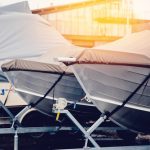Winterizing Your Boat: Protecting Your Vessel in Cold Climates
November 8, 2023 11:43 pm Leave your thoughts
Thorough Cleaning and Inspection
Before embarking on the winterization process, start by giving your boat a thorough cleaning. Remove any debris, dirt, or saltwater residue that may have accumulated during the boating season. A clean surface provides a solid foundation for the next steps and helps prevent corrosion. After cleaning, conduct a comprehensive inspection to identify any existing issues that need attention. Look for signs of wear and tear, loose fittings, or leaks, and address them promptly.
Engine and Fuel System Maintenance
Properly preparing the engine and fuel system is paramount for a smooth transition into winter. Begin by changing the oil and oil filter, ensuring that the engine is protected from moisture and contaminants during the dormant period. Stabilize the fuel system by adding a fuel stabilizer to the gas tank. This prevents the formation of varnish and deposits in the fuel lines and carburetor. Run the engine for a few minutes to circulate the treated fuel throughout the system.
Flush the Cooling System
To prevent any residual water from freezing and causing damage, flush the cooling system with antifreeze. Follow the manufacturer’s guidelines for the correct antifreeze type and mixture. This step is crucial in protecting the engine, water pump, and other components from the potential hazards of freezing temperatures. Remember to drain any water from the engine block and exhaust system before introducing the antifreeze.
Battery Care
Batteries can suffer in cold weather, losing their charge and potentially freezing. Remove the boat’s battery and store it in a cool, dry place. It’s advisable to charge the battery periodically throughout the winter to maintain its health. Consider using a battery maintainer or trickle charger to keep it at an optimal charge level. Inspect the battery terminals for corrosion and clean them with a wire brush if necessary.
Protective Coatings and Lubrication
Applying protective coatings and lubricants is a crucial step in preventing corrosion and ensuring that your boat’s moving parts remain functional. Coat metal surfaces with a corrosion inhibitor or a moisture-displacing lubricant. Lubricate moving parts such as hinges, cables, and steering systems to prevent them from seizing up during the winter months. This extra layer of protection goes a long way in maintaining the integrity of your boat’s components.
Remove Valuables and Electronics
Before storing your boat for the winter, remove any valuable items, electronics, and personal belongings. Items such as life jackets, fire extinguishers, and emergency equipment should be taken off the boat for inspection and proper storage. Electronics like fish finders, GPS units, and radios should be removed to prevent theft and to protect them from the potential damaging effects of extreme cold.
Winterization of Freshwater Systems
If your boat is equipped with freshwater systems, ensure they are properly winterized. Drain the water tanks, water lines, and water heaters to prevent freezing. Use compressed air to blow out any remaining water from the system. Add antifreeze to the water lines to protect against residual water freezing and causing damage. Taking these steps will safeguard your boat’s plumbing and prevent costly repairs in the spring.
Choose the Right Storage Option
Selecting the appropriate storage option is a critical decision in the winterization process. Indoor storage, such as a heated facility or a dry stack, provides the best protection against the elements. If indoor storage is not feasible, consider using a high-quality boat cover designed for winter conditions. Ensure the cover is properly secured to prevent wind damage and the infiltration of snow and moisture.
Regular Checkups during Winter
While your boat is in storage, it’s essential to periodically check on it. Ensure that the cover is intact, inspect for any signs of water infiltration, and verify that the storage area remains dry. If possible, visit your boat to check on its overall condition. This proactive approach allows you to address any issues promptly and prevents small problems from escalating into major repairs.
Summary
Winterizing your boat is a comprehensive process that involves attention to detail and a proactive mindset. By following these steps, you can protect your vessel from the detrimental effects of cold weather and ensure that it’s ready to hit the water again when spring arrives. Remember, a well-maintained boat not only preserves its longevity but also enhances your overall boating experience. So, invest the time and effort now to reap the rewards in the seasons to come.
Need a Boat Marina in Lewiston, CA?
Trinity Alps Marina is a family owned and operated company providing a full line of quality marine services and products to Trinity County. In business since 2003, we specialize in affordable houseboat rentals, ski boats, fishing boats, and patio boat rentals. We have a full line of houseboats and fishing vessels and are dedicated to providing our customers with safe, clean and well maintained vessels. We are open seasonally from June through October. See our website or call us today for the the most accurate driving directions.
Categorised in: Boat Maintenance, Boat Tips
This post was written by admin
